The first and most important thing is to determine what your organization wants to achieve with Google Ads campaigns.
If we don’t have well-defined conversions, it’s almost impossible to have good results in Google Ads. A poor choice or configuration of conversions brings significant problems:
- You will lack information to optimize your account and increase results. You won’t be able to tell which keywords, ads or landing pages are successful and which are useless.
- Google’s automatic bidding system will be ”disoriented” and give you bad results. Its artificial intelligence needs to know for what goals it should optimize your campaigns. Otherwise it will not work correctly.
- Google can disable your account (having properly-configured conversions is one of the Ad Grants requirements since 2018).
4.1. Selecting goals
The ideal goals for Google Ad Grants have to meet several requirements:
- Be really important to your organization. For example: Getting more donations, volunteers or emails. You should avoid irrelevant goals such as visits that spend more than X seconds on your website.
- Be measurable online. You must be able to register the event every time it happens on your website. Actions that occur outside your website or in-person usually cannot be measured and therefore are not valid for this (except for calls, which can be registered with Google Ads call-tracking system).
- Have enough volume. If it happens less than 10 times a month, it’s not a good goal to use in Google Ads. Ideally, each action/conversion should happen more than 50 times a month (so Google’s AI has more data to learn and optimize), but it’s not required to have so much volume.
Each organization has different goals, but the most frequent conversions for nonprofits are:
- Get donations (online, offline, in-kind, memberships…)
- Increase event attendees (online or in person)
- Increase online sales (products or services, tickets for events…)
- Get users to organize more campaigns or ”peer-to-peer” fundraising events
- Capture emails (newsletter subscribers, possible donors…)
- Increase followers on social media
- Recruit volunteers
- Collect signatures for petitions
- Reach beneficiaries or clients of the organization’s programs
- Attract sponsors or corporate partners
- Increase calls
- Increase online chats
- Receive more emails
- Promote specific campaigns (e.g., Giving Tuesday, Christmas cards…)
- Increase visits to certain web pages
- Increase visits to informative articles that are fundamental to the organization’s mission
- Increase downloads of certain online resources (PDFs, tools, apps…)
- Increase interactions with certain Web contents (videos, surveys, search engines, buttons to print or share on social networks…)
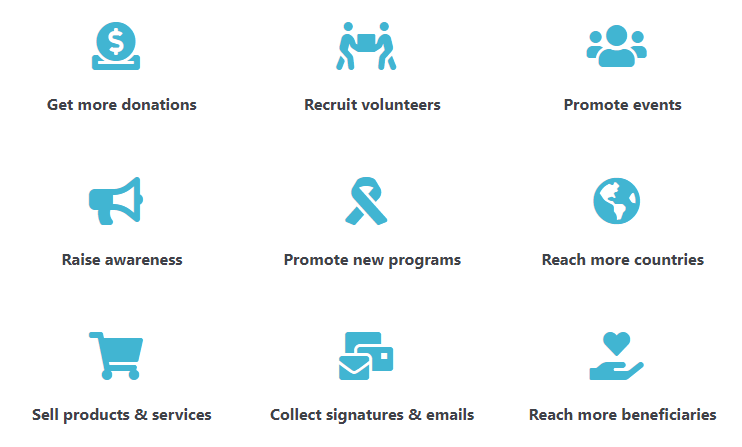
Depending on your goals and the volume of conversions, you will have to decide whether to give more weight to:
- Micro-conversions: Actions whose impact on the organization is indirect and/or not very big. For example, a user watching a video or signing up for the newsletter.
- Macro-conversions: Actions with a direct and significant impact on the organization. For example, receiving a donation or adding a new volunteer.
If we have a high volume of macro-conversions, it’s probably best to configure only those as our campaigns’ goals.
However, if we have a low volume of macro-conversions, it’s recommended to include also micro-conversions as our Google Ads campaigns’ goals. Otherwise, Google’s AI will not have enough data to learn what works best and optimize campaigns properly.
It also depends on the focus of each campaign. If they are ”top-of-funnel” campaigns (whose main goal is to inform and raise awareness) or ”bottom-of-funnel” (whose main goals is to increase macro-conversions such as donations or volunteers).
4.2. Conversion settings
To configure new conversions, you must enter the top menú ”TOOLS AND SETTINGS” > “MEASUREMENT” section> “Conversions” and then click on the blue ”+” button
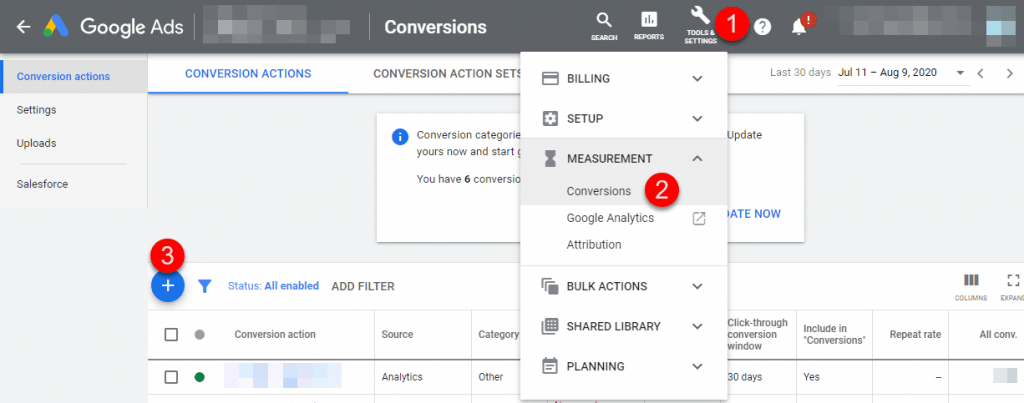
In general, we recommend to import the goals from Google Analytics. You don’t have to import all the goals you have in Analytics, only those relevant to Google Ads campaigns.
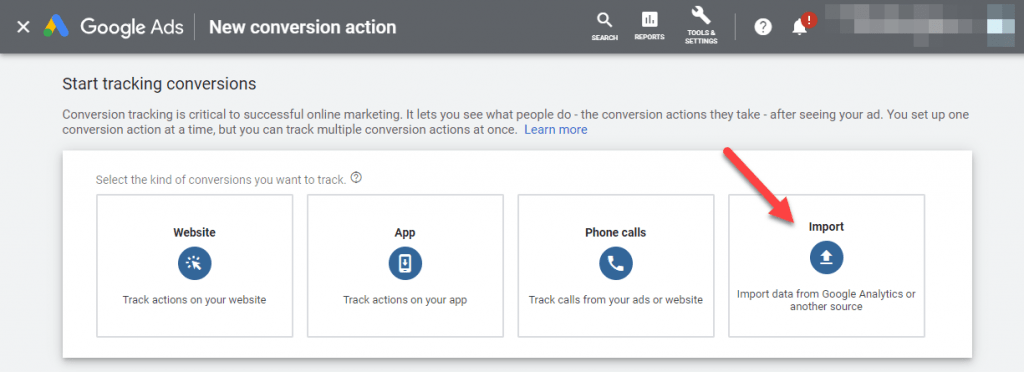
If you don’t have any conversion configured in Google Analytics or you don’t have the your Google Analytics and Google Ads accounts linked, you should fix it as soon as possible (these are serious errors and relatively easy to fix).
You may find it easier to set up conversion tracking using Google Tag Manager. You have more information about setting up events and goals using Google Tag Manager in this official video.
You also have to think carefully about the configuration of each conversion inside Google Ads. You should think about the following questions:
- What is the value of each conversion? Even for conversions without a clear monetary value, we recommend giving an approximate value based on internal data or according to your organization’s priorities. That way, Google AI can know which goals are most valuable to your organization. For example, recruiting a new volunteer probably has a high value for the organization ($300 maybe), while a new newsletter subscriber will have significantly less ($10 maybe).
- Does it have value every time the user does it or only the first time? Accordingly, we will configure it to count several conversions or only one if the same user completes that action several times. For example, if a user makes 5 donations it has value those 5 times (so we will select ”All” in the ”Count” section). But if a user sends the subscription form to the newsletter 5 times it’s not more valuable than if they send it only 1 time (so we will select ”One” in the ”Count” section).
- How soon is it reasonable to expect a conversion? Accordingly, we will configure the time of the post-click conversion window. In general, we recommend setting it to the maximum of 90 days, especially for macro-conversions that usually take more time (for example, users can take weeks or months to decide to donate)
- Which attribution model fits best? In general, we recommend ”Time decay”, not ”Last click” as it comes by default. You can see more details of the different attribution models in this link and this video.
Here you can see the data Google Ads will request when configuring a new goal:
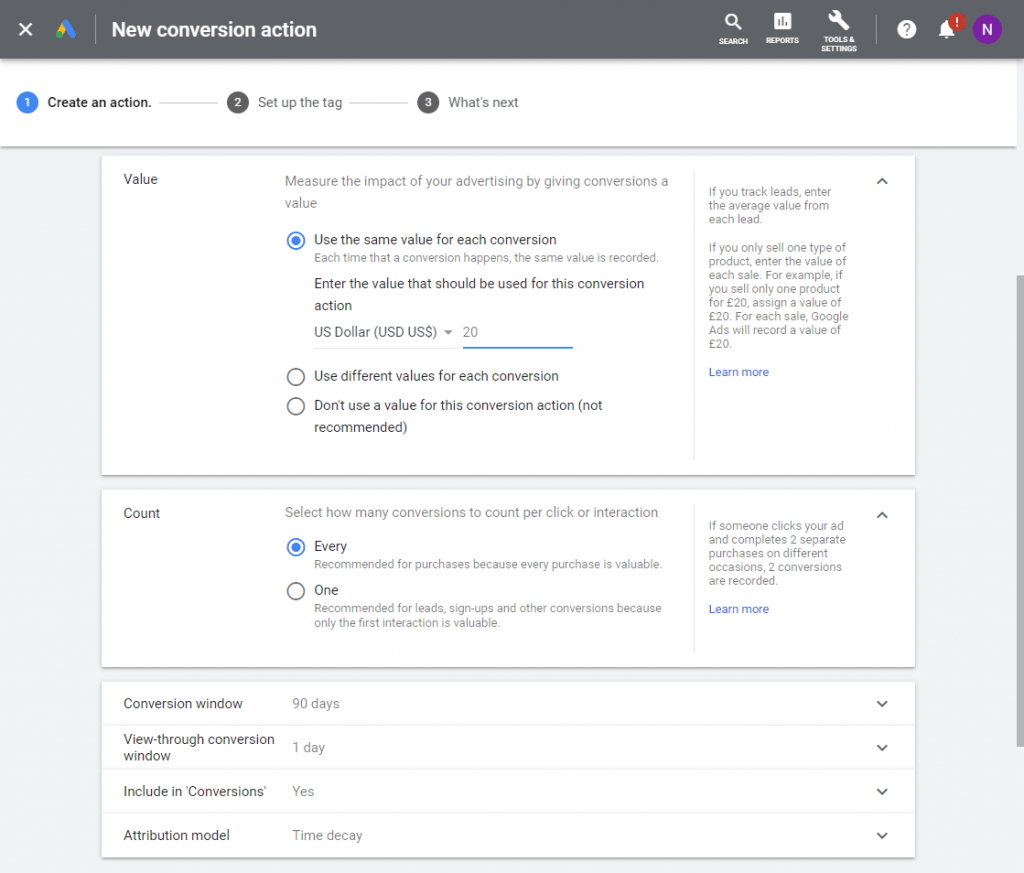
You can find more information about how to configure each conversion in this article in Google Ads. Although as we have mentioned above, in general we recommend configuring the goals in Google Analytics and importing them into Google Ads.
4.3. Review existing conversions
If you have an account with campaigns already running, we recommend checking that the conversions are configured properly.
You can check this in the top menu of ”TOOLS” > then ”MEASUREMENT” > “Conversions”.

Possible errors or problems you may encounter:
- If on that page you see that there is no conversions configured, you should set up one conversion (or several) as soon as possible.
- If it shows any conversion with an error in th e”Status” column, check their settings.
- If they are well configured but are receiving 0 conversions (or very few), you should probably add new conversions that have more volume (Google’s AI don’t work well without very low conversion volume).
- If your Google Ads account includes goals that are not really a priority for your organization (for example, that visitors stay for more than X seconds on your website), we recommend removing them. You should leave only the goals/conversions that really have a clear value for your organization (new donations, volunteers, subscribers, event attendees…). This is especially important if you are already spending all your Google Ad Grants budget ($329/day).
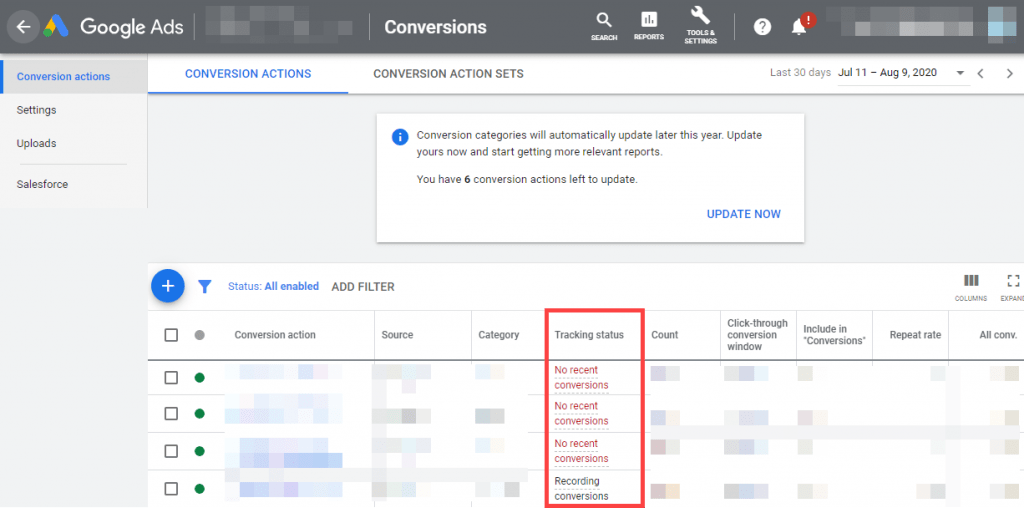
For more information on how to check and configure conversions in Google Ads, you can read this article.